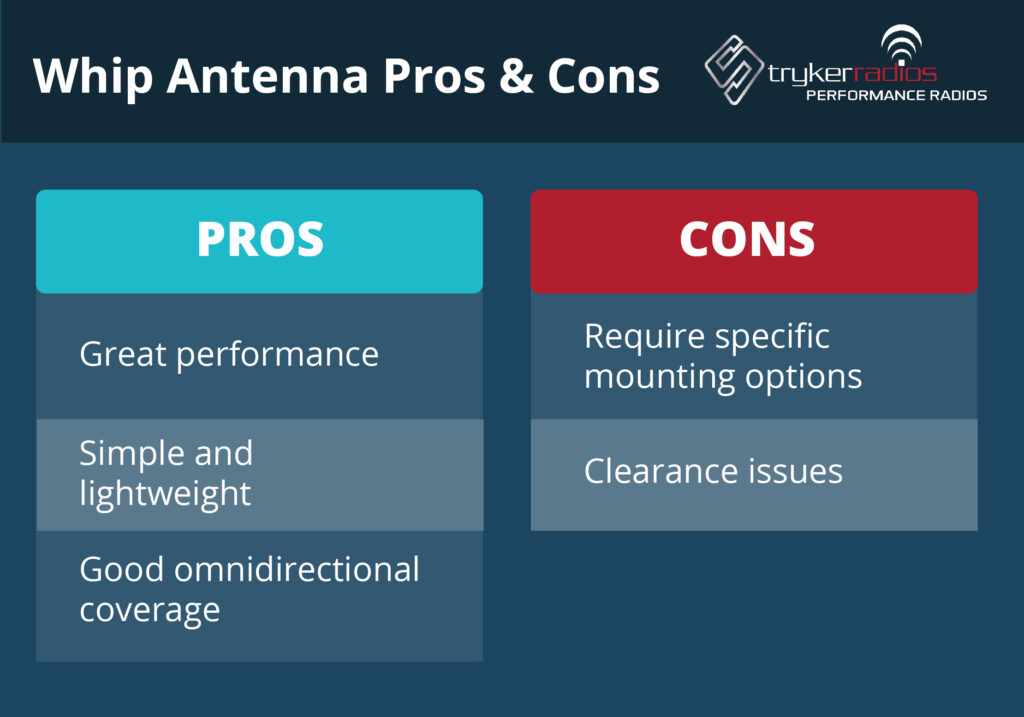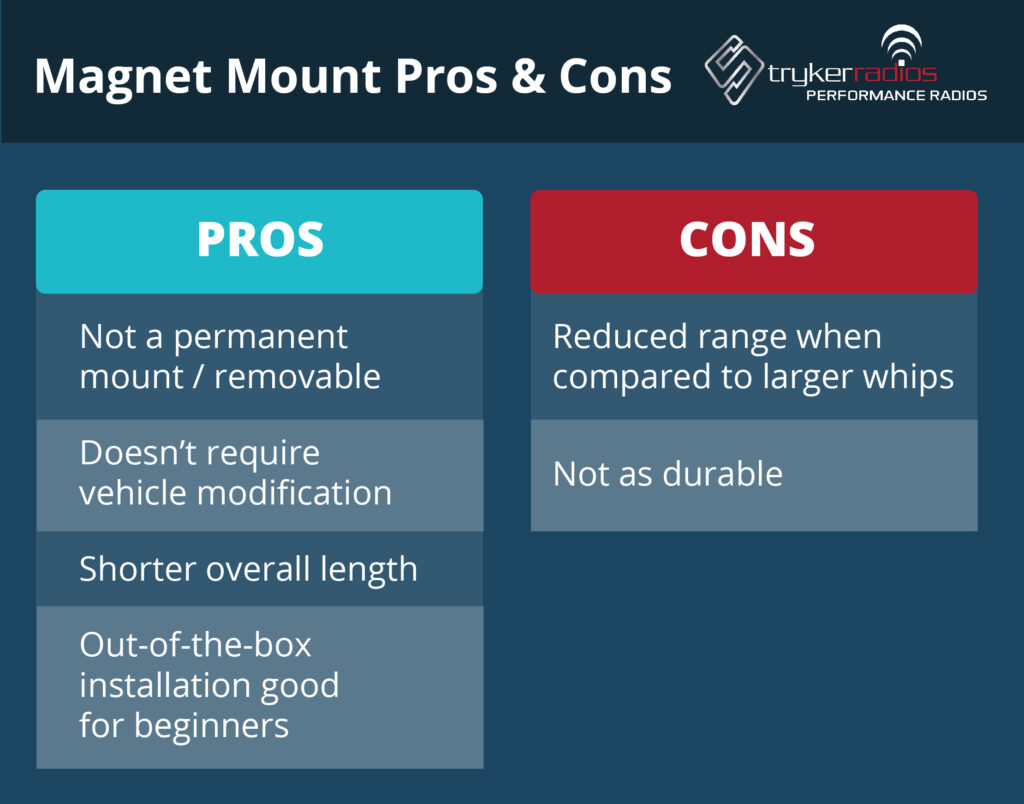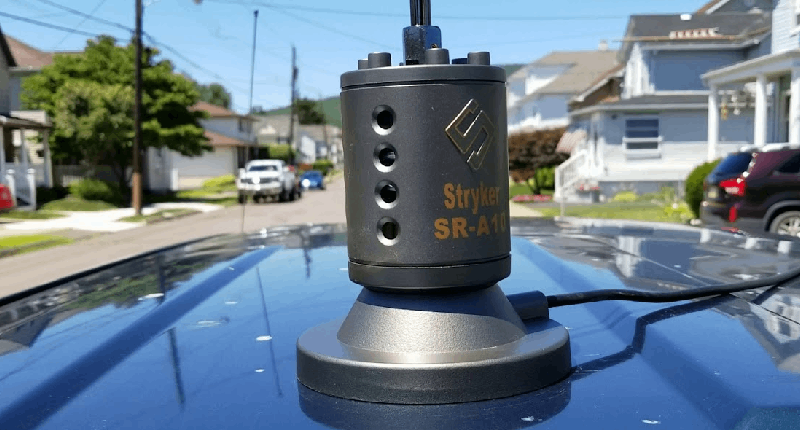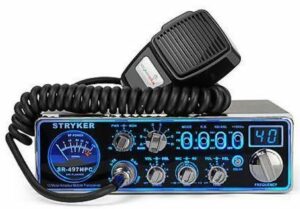Choosing which CB antenna to run on your truck is critical to your overall success and should not be taken lightly. The market has many different antenna types, but which is the best?
The answer depends on the specifics of your setup, the vehicle you are mounting it on, and the environment in which the vehicle will be operating. However, two of the most common choices are whip antennas and magnet mount antennas. Both antennas have pros and cons, so understanding them will help you decide which works best for you.
What is a CB whip antenna?
One of the most popular antennas you will hear people talking about is a whip antenna, but what exactly is it? A whip antenna consists of a flexible, slender, and elongated metal rod. They are typically mounted vertically on a vehicle. CB whip antennas are relatively simple in design. Some whips are made of a flexible fiberglass rod around a wire core, while others are made of stainless steel.
CB whip antennas come in various lengths, and their performance is affected by height, ground plane, and the surrounding environment. Whips can be less than three feet or as long as 11 feet. Generally, the longer the whip antenna, the better its performance and range. The best-performing antenna you can use on a CB radio is a 102-inch whip because 102” is a perfect ¼ wavelength. All other shorter antennas utilize coiled wire to achieve the 102 inches. Although having the complete 102 is the best option, the practical length of the antenna is limited depending on the specific vehicle and its use.
What is the range of a whip antenna?
Because the specifics of the entire setup and the operating environment combine to affect the range, it’s tough to nail down the exact range, but you can expect a 10-mile range with a whip antenna.
Some of the factors that can affect the range:
- antenna length and type
- terrain
- installation quality
- mount location
- antenna quality
Antenna Length/Type
Generally speaking, a long antenna will provide a better range than a short antenna as long as everything else is equal.
Additionally, certain types of antennas will perform better than others regarding range. One example is that center-load antennas often have more range than similar-length fiberglass antennas.
Terrain
One of the most influential factors on range is the surrounding terrain. When transmitting on a radio, you are sending out radio waves in an attempt to reach someone else’s antenna. The more obstacles blocking the path, the harder it is for the signals to get there.
Every obstacle will affect the signals, but the Earth has the most significant impact. Tall mountains or canyon walls will drastically lower your range.
Installation Quality
How well the antenna is installed can also have an impact on performance. Failing to ground the antenna properly or using low-quality coax cables or adapters can reduce the effective range, even if the antenna is capable of more. Choosing a heavier RG8X coax over the standard RG58a can help improve the overall performance of your setup, including boosting your range.
Mount Location
How and where an antenna is mounted can significantly affect its potential range. One of the most important considerations is how high the antenna tip is mounted. Generally, the higher, the better.
The top of the antenna needs to be up and above the top of the vehicle for the best range. However, it’s also good to get the load above the vehicle as well to maximize range.
Another option for mounting is to use two separate antennas together in what is known as a Dual CB Antenna. We cover this in another article, A Complete Dual CB Antenna Guide.
Antenna Quality
The overall build quality of the antenna is another important factor. You can make an antenna out of scrap steel and wire, but it will not perform as well as a high-quality name-brand antenna such as Stryker, Wilson, or Firestik.
How do I tune a whip antenna?
When discussing tuning an antenna, we must understand the SWR (Standing Wave Ratio), and why it’s essential. SWR is the ratio of a standing wave’s maximum magnitude or amplitude to its minimum magnitude. It indicates whether there is an impedance mismatch between the load and the internal impedance on a radio frequency (RF) transmission line or waveguide.
To simplify, SWR measures how well the transmitted power is emitted through the antenna into the atmosphere. SWR is critical to the safe operation of the radio and overall performance/range.
When we tune a radio, we attempt to get the SWR as ‘flat’ as possible. To learn more about getting the perfect SWR, check out our article on How to Tune Your CB Antenna for the Lowest SWR
Tuning the Antenna
To tune an antenna, begin by adjusting the overall length of the antenna by small amounts. An SWR meter is connected in line between the radio and the antenna. Based on the readings, you will either shorten or, in some cases, lengthen the antenna to flatten out the SWR.
The actual process of making the adjustments depends on the brand of antenna. Some antennas, such as some Firestik and Wilson models, have tunable tips that allow you to adjust a set screw and lengthen or shorten the adjustable tips. Others, like the ProComm JBC series, have adjustable rings to fine-tune the antenna.
For antennas that don’t have tuning devices built in, you cut the antenna to shorten it, usually, about ¼ inch at a time to tune it properly. Adjusting other components, such as the length of the coax cable, springs, and connectors, can also adjust the SWR.

What about ground plane?
The availability of a ground plane can also affect your choice of antenna. A ground plane is a metal surface the antenna utilizes as a reflector to send the transmit signal into the atmosphere. On a vehicle, the ground plane is the body or frame.
Both CB whip antennas and magnet mount antennas use the vehicle’s metal body as the ground plane. Whether your mounting location provides an adequate ground plane can affect your antenna options. Special antennas called NGP, or Non-Ground Plane antennas, substitute the earth, or water in boats, as the ground plane. These require an NGP antenna kit that includes special coax and connectors.
When should I use a whip antenna?
When deciding on a type of antenna, one of the most important considerations is the environment the vehicle is going to be operating in. Suppose you are working on an off-road vehicle operating in desert conditions so you don’t have to worry about trees or other structures. In that case, you can use a large stainless steel whip, such as the 102 mentioned above, mounted to the top of the vehicle without worry. However, if you are working on a mini-van that operates in a city environment, you will need something shorter since 102 inches is 8.5 feet of stainless steel whip!
Whip antennas also have to be installed in a dedicated antenna mount. While many mounting options exist, some vehicles require modification. If you are mounting an antenna on a vehicle where modification isn’t an option, you could run into issues properly installing a whip.
You also want to ensure the mount can take the forces the whip will exert as it moves in the wind. Because of this, whips are often mounted with a barrel spring on the bottom to absorb some of the force. A popular mounting option is a heavy-duty ball mount. Keep in mind that you can tie down whips when they are not in use.

What is a magnet mount antenna?
Magnet mount antennas utilize a strong magnet in its base to attach the antenna to your vehicle. Magnet mounts are often used on cars, pickup trucks, and SUVs since they are not permanent mounts and don’t require you to modify the vehicle.
Magnet mounts use a coil in their base to make the overall length much shorter and more appropriate for vehicles operating in environments with clearance concerns.
What is the range of a magnet mount antenna?
The overall range of a magnet mount antenna is subject to the same factors mentioned above. However, magnet mounts will generally have less range than a whip antenna.
One especially important factor that will affect the range of your magnet mount is its installation. Ensuring the right mounting location to give the antenna a proper ground plane can be crucial to your signal strength. For more details, check out this article about how to install a magnet mount CB antenna.
Magnet mount antennas come in various sizes from around 18 inches up to 62 inches. Each length will have different range capabilities. One common magnet mount is the Wilson antennas Little Wil, a 36” magnet mount with an advertised range of up to four miles. The larger Wilson 1000 magnet mount has an advertised range of five-plus miles. Stryker’s SR-A10 Magnetic Mount provides a strong base, great looks, and excellent range.
How do I tune a magnet mount antenna?
Tuning a magnet mount antenna follows the same principles as tuning a whip antenna, but the method for adjusting the length is different. Most magnet mounts are tuned by adjusting how far the antenna extends from the base. This is often accomplished by loosening set screws on the base, allowing the antenna to slide up and down inside the base. You let the antenna go all the way down into the base and then take an SWR reading. You can slowly lengthen the antenna by pulling it farther out of the base until your SWR flattens out.
When should I use a magnetic mount antenna?
Magnet mount antennas are best when you need a shorter antenna or don’t want to permanently mount an antenna to your vehicle. They are often favored when installing a CB radio in passenger vehicles such as cars or pickup trucks.
Magnet mount antennas also come ready to use out of the box without buying or installing additional components such as coax or mounts which makes them attractive for beginners trying to get their setup up and running.
Another situation where you may need to use a magnet mount is when you can’t find a mount or mounting location for your vehicle. The ability to attach the base to any metal gives you some leeway on where to place the antenna.
While using a magnet mount will generally deliver less effective range than a longer stainless steel whip antenna, the technology is improving. New models can yield impressive range while giving you the flexibility of a magnet mount.
If you are looking for a magnetic mount antenna, check out Stryker’s SR-A10 Magnetic Mount CB Antenna. This powerful, high-performance antenna sports a double-wall coil cover, six gauge solid copper 100% silver plate wire, and a robust magnetic base. It’s ideal for cars, 4×4s, jeeps, or commercial vehicles.

What About Ham Antennas?
While some CB antennas can be used for ham radios, they generally need a whole different type of antenna system. For more information about ham antennas, read our article on the different types of ham radio antennas.
Which CB radio antenna is better?
You must consider many factors when looking for the best antenna for your setup. For maximum range, you want to use the longest antenna and mount it as high as possible. The environment you are operating in is one of the most significant factors limiting the size and style of antenna you can use.
If you can run a 102-inch CB antenna, it will deliver you the most range of any of the standard options available. These whip antennas work well in situations where you can permanently mount the long antenna and don’t have to worry about clearance. They are also a good choice when working with a base station rather than a vehicle. However, if you need to worry about overhead clearance, you may need to use a smaller whip, such as a center-loaded ‘trucker’ antenna, like the Stryker SR-A10 CB Antenna.
The magnet mount antenna is perfect for setups requiring additional clearance, for beginners just getting started, and for vehicles that require a non-permanent solution.
Easy installation that doesn’t modify the vehicle makes the magnet mount a popular choice. On some models, such as the Stryker SR-A10, the antenna can be removed from the base and stored inside the vehicle when not in use, which provides additional overhead clearance and prevents damage or theft.
Because the magnet mount antennas are significantly shorter than the whip antennas, you don’t have to worry as much about overhead clearance. This means they can be used on many different types of vehicles and in more environments.
Evaluate the factors affecting your setup and choose the best CB antenna for your situation. Always maximize height and length where appropriate while also understanding your operating environment. Remember Stryker always uses the best raw materials and cutting-edge technology to deliver quality and reliability you can trust!



